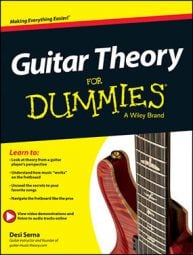To number the relative minor on the guitar, remember the major scale has seven degrees with a triad built on each one. In music, uppercase Roman numerals represent major chords, and lowercase Roman numerals represent minor chords, as you can see in this example:
1-2-3-4-5-6-7
I-ii-iii-IV-V-vi-viif5
You may recognize this example as the major scale. After all, in music, you use the major scale as your starting place for naming chords, scale degrees, and intervals. From this perspective, the pattern of whole steps and half steps between the scale degrees of the major scale are what you think of as the naturally occurring ones.
If the distance between any two scale degrees changes for some reason, you can reflect this change with an accidental — typically a sharp or a flat. For example, a flattened 3rd scale degree is written f3 and is a half step lower than the one found in a regular major scale.
When numbering scale degrees, you always regard the tonic as 1. Because the tonic in the E minor scale is E, you count the E as 1 and renumber everything else from there, as you see here:
E minor
1-2-f3-4-5-f6-f7
E-Fs-G-A-B-C-D
i-iif5-fIII-iv-v-fVI-fVII
Em-Fsmf5-G-Am-Bm-C-D
Keep in mind that the notes and chords of E minor are still the same as G major. The only difference is that you’ve rearranged the chords to begin with E. Don’t forget to adjust the Roman numerals to match the new order. Because the major/minor sequence changes if you count the E as 1, you adjust the case of the Roman numerals to reflect the correct chord quality for each scale degree.
How to account for any interval changes
When you renumber chords from the tonic, you also need to indicate any changes to the intervals between the chords. Compare the original G major scale with the new E minor scale:
G major
1-2-3-4-5-6-7
G-A-B-C-D-E-Fs
I-ii-iii-IV-V-vi-viif5
G-Am-Bm-C-D-Em-Fsmf5
E minor
1-2-f3-4-5-f6-f7
E-Fs-G-A-B-C-D
i-iif5-fIII-iv-v-fVI-fVII
Em-Fsmf5-G-Am-Bm-C-D
Major scale intervals are what you think of as the naturally occurring ones. In the major scale, the distance from the 1st to 3rd degrees is two whole steps, better known as a major 3rd. But when you start counting from E, the distance from 1 to 3 is only one and a half steps, better known as a minor or flattened 3rd.
Here is what G major looks like on the fretboard as both scale degrees and Roman numeral chords, followed by the same notes and chords numbered to reflect E minor. Notice in the last diagram that you end up playing the same chords either way.
![[Credit: Illustration courtesy of Desi Serna]](https://www.dummies.com/wp-content/uploads/419083.image0.jpg)
There is a brief demonstration on playing in G major and E minor at G Major and E Minor Scales and Chords.
You can identify relative major and minor keys by using the two types of chord patterns shown here. Wherever you move these patterns on the fretboard, chords I and vi are always the relative major and minor.
![[Credit: Illustration courtesy of Desi Serna]](https://www.dummies.com/wp-content/uploads/419084.image1.jpg)
Want to know the relative minor for B? Play a major scale chord pattern starting on B and then move to chord vi. That’s the relative minor — always! Want to know the parent major scale for Csm? Play Csm on the fretboard, count it as vi, and then move to chord I. That’s the relative major — always!
Here are a few more songs based in the relative minor. For your reference, numbering for both the relative minor and relative major is included. You may find it easier to work out the chord progression by number in a familiar major scale pattern first (shown in parentheses) and then renumber it according to its relative minor tonic.
“All Along the Watchtower” by Jimi Hendrix (guitars tuned down one half step to Ef)
Csm-B-A-B
i-fVII-fVI-fVII in Cs minor (vi-V-IV-V in E major)
“Layla” by Eric Clapton
Dm-Bf-C-Dm
i-fVI-fVII-i in D minor (vi-IV-V-vi in F major)
“Smells like Teen Spirit” by Nirvana
F5-Bf5-Af5-Df5
i-iv-fIII-fVI in F minor (vi-ii-I-IV in Af major)
“The Thrill Is Gone” by B.B. King
Bm-Em-Bm-G-Fsm-Bm
i-iv-i-fVI-v-i in B minor (vi-ii-vi-IV-iii-vi in D major)
Basics of implied flats in minor keys
In minor keys, the flattened scale degrees, such as the 3rd and 6th, are often assumed rather than specifically mentioned or written. For example, in the key of E minor, a musician may refer to the G as the 3rd of the key without specifying that it’s the flattened 3rd.
Likewise, the three chord may be written simply as III with the minor key itself implying that it’s fIII. The same is true for fVI and fVII, so you may hear and see them simply referred to as VI and VII.

